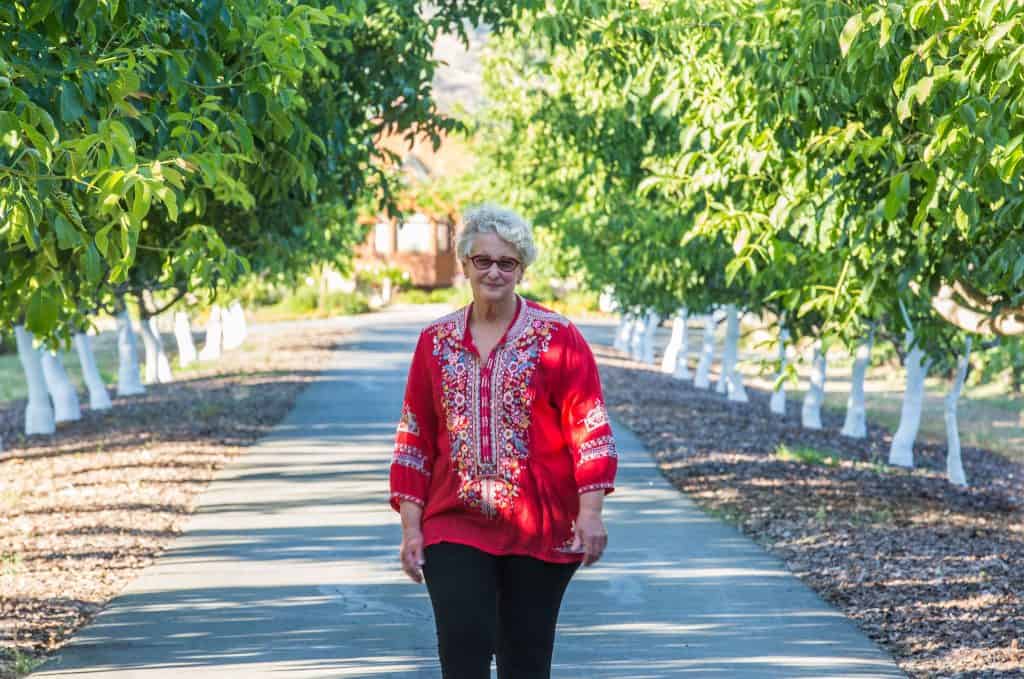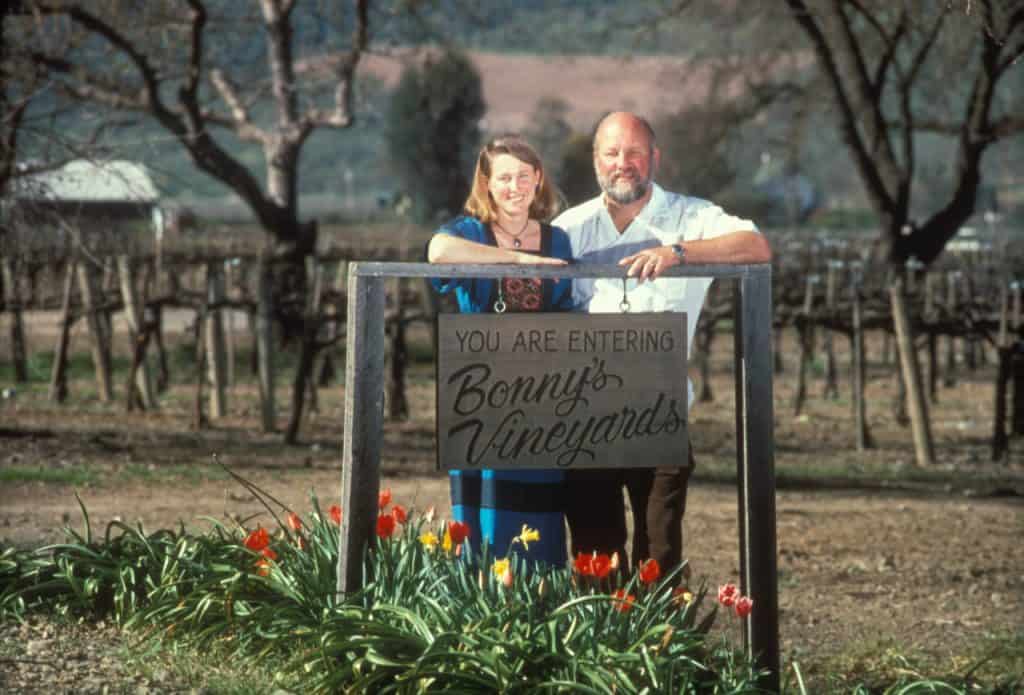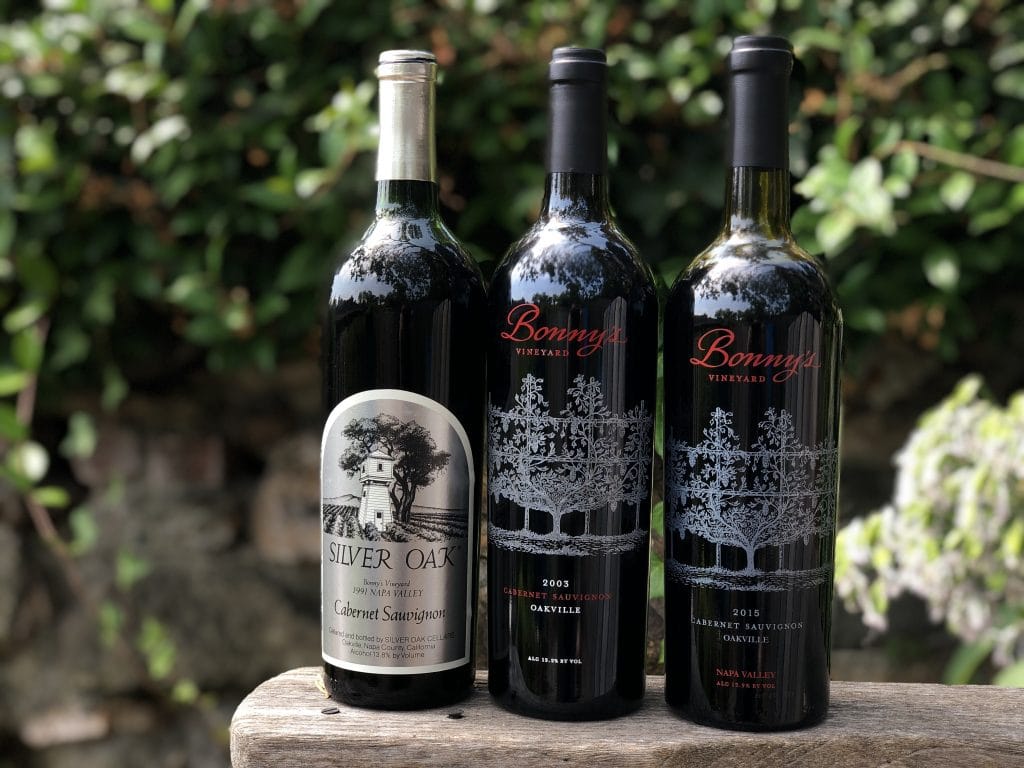Some people have beautifully manicured front lawns. Some people have barely manageable jungles. And some are lucky enough to have one of Napa’s best vineyards right out their front door.
“Mostly, my memories of it growing up are tearing through on ATVs and getting into a lot of trouble,” says Matt Meyer.
When Justin Meyer, the founder and winemaker of the famed Silver Oak Cellars, told his wife in 1974 that he was ripping out the three acres of clover in front of their Oakville home to plant a vineyard, Bonny Meyer suggested that she’d like to make it her own personal project.
“I learned how to drive a tractor, and to sucker and prune grapevines,” she writes in her recently released memoir, Perfectly Paired: the Love Affair Behind Silver Oak Cellars.
Even as the first fruit came off the vines four years later, it was clear that this little, unusually gravelly patch of Napa Valley was something special. Instead of putting it into Silver Oak’s Napa Cabernet, Justin Meyer decided to bottle it separately in 1979, making it one of Napa’s first vineyard-designated wines. The Christmas before the wine was to be released, Meyer surprised his wife with a hand-carved wooden sign, proclaiming to anyone who passed that the little patch of vineyard in their front yard was forever to be known as Bonny’s Vineyard.
In the history of Napa Valley, a legendary place, there are only a few legendary vineyard names: To Kalon. Beckstoffer. Eisele. Martha’s Vineyard, and yes, Bonny’s.

Silver Oak made a Bonny’s Vineyard Cabernet from 1979 until 1991, and from its very first vintage, it was recognized as something special by both ordinary consumers and critics alike. In fact, it became so popular, the winery had to get rid of it.
“I can remember my dad saying after one of their annual August release parties where the Bonny’s sold out in a matter of hours, ‘We’ve got more than a thousand cases of Alexander Valley and Napa Valley Cabernet left, and not a single one of Bonny’s,'” recalls Matt Meyer.
Ultimately deciding they were disappointing more people than they were making happy, the partners in Silver Oak decided to stop making a separate Bonny’s Vineyard lot, and started blending the fruit into their Napa Valley bottling.
But the sign stayed up in front of vines in the Meyer family home, and life went on. Eventually Justin Meyer decided he was ready to retire, and in 2000 sold his share of Silver Oak to his business partner, Ray Duncan. While there was some discussion at the time of Meyer hanging on to a few of the vineyards, ultimately the two amicably decided all the vineyards needed to be a part of the deal.
All except for one. And largely because it was simply the front yard of the family home.

Bonny’s Vineyard was replanted in 1999 and so didn’t begin producing viable fruit again until 2002, when sadly only a month before harvest Justin Meyer died of a heart attack. That year’s harvest proved a somber one for the family, and the single barrel of Bonny’s Vineyard Cabernet they produced under their fledgling Meyer Family Cellars label was not and never will be sold.
“It’s obviously a special wine, and one that we tend to drink only on special occasions with family and our closest friends,” says Matt Meyer.
In 2003, twelve years after the name Bonny’s Vineyard last appeared on a wine label, the family released its first commercially-available Bonny’s Vineyard Cabernet, which they have made ever since, with fruit from the roughly 1.5 acres of the vineyard the family believes represents the best of what the site has to offer. This year, twelve years after that first vintage, the family is releasing the 2015 vintage of the wine.
Which, I suppose, is why I was lucky enough to get a box on my doorstep a few weeks ago containing one of the last remaining bottles of the 1991 Silver Oak “Bonny’s Vineyard” Cabernet, the 2003 Meyer Family “Bonny’s Vineyard” Cabernet, and their soon-to-be-released 2015.
“I was just struck by the symmetry of these two twelve-year periods,” says Meyer, “and thought it would be interesting to look at all three wines.”
No kidding. The opportunity to take a 25-year journey that spans the rise of Napa Valley from emerging wine region to global powerhouse through the lens of three acres of Cabernet Sauvignon is an experience not to be missed.
The profundity of this journey was made possible, in part, by integrity. Meyer, who literally grew up in this vineyard and learned winemaking at the knee of a Napa legend, has spent the past 12 years staying true to what Bonny’s Vineyard Cabernet has always been.
“When it comes to Syrah or the other wines we make, we’re always looking to improve,” says Meyer. “We can make small steps each year, and tune what we’re doing. With Bonny’s we’re doing the opposite. We are trying very hard to make the wine precisely how my father would have made it in 1986. The alcohols have drifted up over the years, but we can’t entirely help that. The old vines were diseased, and while the new ones are happier, they make more sugar. My hardest job is making the vines slow down—getting the maturation I want without the sugar content. We know people who have bottles from a few decades ago, and if they want to open up an old bottle and a current release we want them to be tasting only vintage variation and age, not a new winemaking style.”
Meyer has succeeded magnificently. Making a beautifully balanced, 13.8% alcohol Cabernet Sauvignon in the heart of Oakville is as courageous as it is difficult. Most neighbors are weeks away from picking when Meyer harvests these grapes, and most consumers have become accustomed to the ripe richness of Napa Cabernet at 15% alcohol or higher.
I find it comforting (not to mention delicious) that Bonny’s Vineyard continues to express the beauty that originally led to its fame. If it was one of Napa’s earliest rockstar “cult wines” it has now left the spotlight and stepped off the stage, content to play acoustic sets in small venues but still singing with its distinctive voice and charm.

Tasting Notes
1991 Silver Oak Cellars “Bonny’s Vineyard” Cabernet Sauvignon, Oakville, Napa, California
Medium brick red in the glass with a touch of tawny brown, this wine smells of cedar and forest floor mixed with roasted figs and bacon fat. In the mouth, beautiful dried herbs and dried cherry mix with dried flowers and saddle leather flavors. The tannins are a whisper at this point, a powdery cloud that adds some texture to the very pretty aromatics of this cedary meaty goodness. Beautiful in its age. 13.8% alcohol. Score: between 9 and 9.5. Cost: $220. click to buy.
2003 Meyer Family Cellars “Bonny’s Vineyard” Cabernet Sauvignon, Oakville, Napa, California
Dark ruby in the glass with a hint of brick red at the rim, this wine smells of dried cherries, cedar, and crushed herbs. In the mouth, herbal and cedar notes have a wonderful earthy backdrop to them and powdery tannins that offer a fleecy blanket into which the fruit can nestle. Very pretty with still bright acidity. Excellent. 13.2% alcohol. Score: around 9. Cost: $145. click to buy.
2015 Meyer Family Cellars “Bonny’s Vineyard” Cabernet Sauvignon, Oakville, Napa, California
Medium to dark garnet in the glass, this wine smells of cherry and chopped herbs. In the mouth, very fine-grained, muscular tannins wrap around a core of cherry and green herbs that have a lovely cool restraint to them that is quite refreshing and tasty. Excellent acidity and a remarkably modest 13.9% alcohol. Score: between 9 and 9.5. Cost: $145. This wine will be available for purchase in October by members of the winery’s mailing list.
Full disclosure: these wines were provided as press samples.